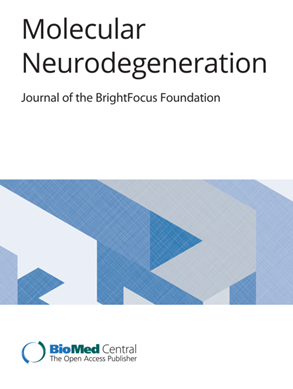Multi-region brain transcriptomic analysis of amyotrophic lateral sclerosis reveals widespread RNA alterations and substantial cerebellum involvement
IF 17.5
1区 医学
Q1 NEUROSCIENCES
引用次数: 0
Abstract
Amyotrophic lateral sclerosis (ALS) is a neurodegenerative disease that primarily affects the motor neurons, causing progressive muscle weakness and paralysis. While research has focused on understanding pathological mechanisms in the motor cortex and spinal cord, there is growing evidence that extra-motor brain regions may also play a role in the pathogenesis or progression of ALS. We generated 165 sample-matched post-mortem brain transcriptomes from 22 sporadic ALS patients with pTDP-43 pathological staging and 11 non-neurological controls. For each individual, five brain regions underwent mRNA sequencing: motor cortex (pTDP-43 inclusions always present), prefrontal cortex and hippocampus (pTDP-43 inclusions sometimes present), and occipital cortex and cerebellum (pTDP-43 inclusions rarely present). We examined gene expression, cell-type composition, transcript usage (% contribution of a transcript to total gene expression) and alternative splicing, comparing ALS-specific changes between brain regions. We also considered whether post-mortem pTDP-43 pathological stage classification defined ALS subgroups with distinct gene expression profiles. Significant gene expression changes were observed in ALS cases for all five brain regions, with the cerebellum demonstrating the largest number of total (> 3,000) and unique (60%) differentially expressed genes. Pathway enrichment and predicted activity were largely concordant across brain regions, suggesting that ALS-linked mechanisms, including inflammation, mitochondrial dysfunction and oxidative stress, are also dysregulated in non-motor brain regions. Switches in transcript usage were identified for a small set of genes including increased usage of a POLDIP3 transcript, associated with TDP-43 loss-of-function, in the cerebellum and a XBP1 transcript, indicative of unfolded protein response activity, in the motor cortex. Extensive variation in RNA splicing was identified in the ALS brain, with 26–41% of alternatively spliced genes unique to a given brain region. This included detection of TDP-43-associated cryptic splicing events such as the STMN2 cryptic exon which was shown to have a pTDP-43 pathology-specific expression pattern. Finally, ALS patients with stage 4 pTDP-43 pathology demonstrated distinct gene and protein expression changes in the cerebellum. Together our findings highlighted widespread transcriptome alterations in ALS post-mortem brain and showed that, despite the absence of pTDP-43 pathology in the cerebellum, extensive and pTDP-43 pathological stage-specific RNA changes are evident in this brain region.肌萎缩侧索硬化症的多区域脑转录组学分析揭示了广泛的RNA改变和小脑的大量受累
肌萎缩性侧索硬化症(ALS)是一种神经退行性疾病,主要影响运动神经元,导致进行性肌肉无力和瘫痪。虽然研究的重点是了解运动皮层和脊髓的病理机制,但越来越多的证据表明,运动外脑区域也可能在ALS的发病或进展中发挥作用。我们从22例具有pTDP-43病理分期的散发性ALS患者和11例非神经系统对照中获得了165个样本匹配的死后脑转录组。对每个个体进行了五个脑区mRNA测序:运动皮层(pTDP-43包涵体总是存在)、前额皮质和海马(pTDP-43包涵体有时存在)、枕皮质和小脑(pTDP-43包涵体很少存在)。我们检测了基因表达、细胞类型组成、转录物使用(转录物对总基因表达的贡献百分比)和选择性剪接,比较了大脑区域之间als特异性的变化。我们还考虑了死后pTDP-43病理分期是否定义了具有不同基因表达谱的ALS亚组。在ALS病例中,所有五个脑区均观察到显著的基因表达变化,其中小脑显示出最多的总差异表达基因(约3000个)和独特的差异表达基因(60%)。通路富集和预测活性在脑区域之间基本一致,这表明与als相关的机制,包括炎症、线粒体功能障碍和氧化应激,在非运动脑区域也失调。转录物使用的开关被鉴定为一小组基因,包括在小脑中增加POLDIP3转录物的使用,与TDP-43功能丧失相关,在运动皮层中增加XBP1转录物的使用,表明未折叠的蛋白质反应活性。在ALS大脑中发现了RNA剪接的广泛变异,26-41%的选择性剪接基因是特定大脑区域所特有的。这包括检测tdp -43相关的隐剪接事件,如STMN2隐外显子,其被证明具有pTDP-43病理特异性表达模式。最后,4期pTDP-43病理的ALS患者在小脑中表现出明显的基因和蛋白表达变化。总之,我们的研究结果强调了ALS死后大脑中广泛的转录组改变,并表明,尽管小脑中没有pTDP-43病理,但该脑区域广泛且pTDP-43病理阶段特异性RNA的变化是明显的。
本文章由计算机程序翻译,如有差异,请以英文原文为准。
求助全文
约1分钟内获得全文
求助全文
来源期刊

Molecular Neurodegeneration
医学-神经科学
CiteScore
23.00
自引率
4.60%
发文量
78
审稿时长
6-12 weeks
期刊介绍:
Molecular Neurodegeneration, an open-access, peer-reviewed journal, comprehensively covers neurodegeneration research at the molecular and cellular levels.
Neurodegenerative diseases, such as Alzheimer's, Parkinson's, Huntington's, and prion diseases, fall under its purview. These disorders, often linked to advanced aging and characterized by varying degrees of dementia, pose a significant public health concern with the growing aging population. Recent strides in understanding the molecular and cellular mechanisms of these neurodegenerative disorders offer valuable insights into their pathogenesis.
 求助内容:
求助内容: 应助结果提醒方式:
应助结果提醒方式:


